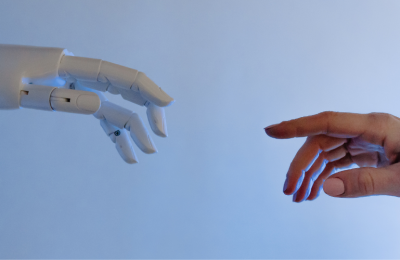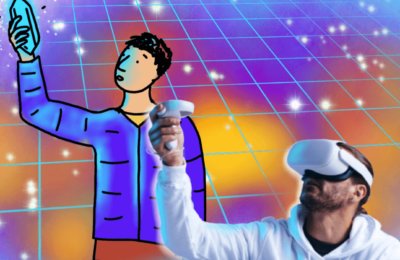Read what Bryan Gildenberg, SVP of Commerce at OCG, sees as the most important commerce technologies to emerge from this year’s CES show and the implications it has on future trends.
Well, CES 2022 (Consumer Electronic Show), was certainly interesting – having never been before I have nothing to benchmark it against but was great to connect with old friends and new! Earlier this month we posted a three-part series of thoughts on what I saw there through a decidedly retail and commerce lens. These thoughts ranged from the future of data, analytics the “practical metaverse”, data twinning and simple AR applications to name a few – and of course, it wouldn’t be 2022 without some thoughts on the Metaverse! An internal acronym here for Omnicom is OMC, which I’ve begun to joke it should stand for “Obligatory Metaverse Conversation”. Enjoy reading these “Through A Commerce Lens” observations, as all these trends should be interesting to watch in 2022 and beyond.
Data science in the 2020s will be less about data and more about science – true science. You will be able to know anything, and EVERYTHING will be easy to measure. The amount of money being put into systems that monitor, record, recognize and process people, things, environments, and body functions is, truly, astonishing. Leaders will have to pick and construct meaningful KPIs out of this ocean of observed phenomena.
Commerce Implications: combining granular metrics into meaningful metrics is the real work of commerce data science in the 2020s.
The gap between omni-present granular data and how resources and capital are allocated in most of the companies that represent most of the GDP in the world is gargantuan. VCs are investing in millions of companies that act as aggregational middleware between this ocean of data and scalable opportunities. Watching players that can be more commercially nimble and less constrained by the old regulatory restricted model outmaneuver entrenched players will be a multi-trillion-dollar re-allocation of market value during the 2020s as improved data gets linked to better health outcomes and lower healthcare costs.
Commerce Implications: retail-centric healthcare will use this new ecosystem of alternative health management models, combined with commercial data, to help shoppers manage their healthy lives better.
Parallel ecosystems are evolving in the B2B metaverse which is “twinning”, or the practical metaverse. The idea is to build an exact replica of something and then observe how it responds to complex stimuli – it’s the metaverse with a purpose. Whether it’s the COVID-19 virus, the human heart, traffic patterns or the composition of the atmosphere, it is now possible to build an accurate model of complex systems, and then test/validate shocks and changes to that system.
Commerce Implications: Using the practical metaverse to predict the impact of anything that happens in a physical/digital retail space, and then modelling those spaces based on how it drives the most important KPIs, will gain traction across retailers.
The other critical part of the practical metaverse is the development of low-cost unobtrusive AR enabled eyewear, allowing a machinist to see exactly how to assemble a hydraulic pump, or closer to home for us, a store associate to see exactly how to planogram a shelf.
Commerce Implications: Planogram compliance will become more like “pick to the light” DC fulfilment – a remarkably accurate and old technology that allows simple visual cues to govern repetitive and highly detailed work.
The metaverse appears to have some much better near-in applications when compared to the world of NFTs/blockchain/Web3.0. A lot of the use cases discussed at CES were around NFTs, particularly NFTs of visual images.
Commerce Implications: The way the visual art world has been able to create an entire ecosystem out of NFT’s, is a harbinger of things to come as it tries to address some key issues that are endemic to creativity in the digital space. Expect the entire world of entertainment & commercial commerce to begin to develop attributes of this. Of particular interest is the ability to enforce commercial terms around resale of an item, which could have massive implications for industries like recorded music and event ticketing.
The underrated critical part of the metaverse is a decidedly un-metaversey comms platform Discord, a community management platform that enables large group-text style chats between friends or people who share an interest. Originally a platform used by gamers interested in the likes of Minecraft and Roblox it is today, according to some NFT experts The Headquarters of the Metaverse.
Commerce Implications: Discord does not support advertising so will require real endemic understanding to participate in the ongoing conversations that surround the metaverse. Parallel ecosystems are evolving as “twinning”, or the Practical metaverse.
The NFT world can create scarcity, uniqueness, and authenticity in a digital world of easy replication, zero marginal cost production and a high propensity to fakery. The art market needs all these things to function, hence where you would see this ecosystem take root.
Commerce Implications: NFTs will be a huge part of the economics of fame, style, and status – in the same way Amazon took root as a bookstore because the economics and user experience of bookselling lent itself to a different solution, the economics and experience of fandom and fame seem ripe for NFTs to take root here.
It seems impossible to care about the future and not have a significant, strategic presence in the Korean market. It became a running joke to ask the companies where they had gone live with whatever technology they were selling – the answer was inevitably, “We have x number of these up and running in Seoul”.
Commerce Implications: Companies should use Korea for what they’re using China for today – a Dr. Strange like portal to see the future through. China’s future is so distinctive to China, and in many ways markedly less certain than Korea’s.
Adaptivity will be critical. Coresight Research [quotes] 24% of Americans identify as having a disability – and this number will only increase exponentially, globally, as huge parts of the world’s population pyramid become more top heavy. Simple tools to assist visual and auditory impairment, mobility or even lamps that are designed to improve reading for dyslexics will be enormous growth areas.
The economics and necessity of labour force management will accelerate robotic development and adoption – one of the simplest and best things I saw was a simple model from Bear Robotics that basically handles the scut work of waiting tables (it delivers food and picks up dirty dishes). Brilliant in that it helps the restaurant manage predictability, improves job satisfaction for the human and improves service levels/tips (slow basic service is a tip-killer). Robotics that doesn’t need hand-like function are WAY cheaper to develop than robots that have to grab things (the human hand is one of the most complex machines on earth). 2022 should permit the narrative around robotic technology.
Gaming remains a strangely isolated ecosystem. Much of the excitement about the metaverse is from people enamoured with Blockchain, but its basic premise is most easily imagined in the gaming world. Think of popculture 30 years ago existing entirely contained within subculture, instead of being its foundation. Add to that the fact that most people’s first experience with the metaverse will be through some sort of gaming experience, yet it remains a mysteriously under-invested platform by marketers.
Written by Bryan Gildenberg, SVP of Commerce for the Omnicom Commerce Group (OCG).




























